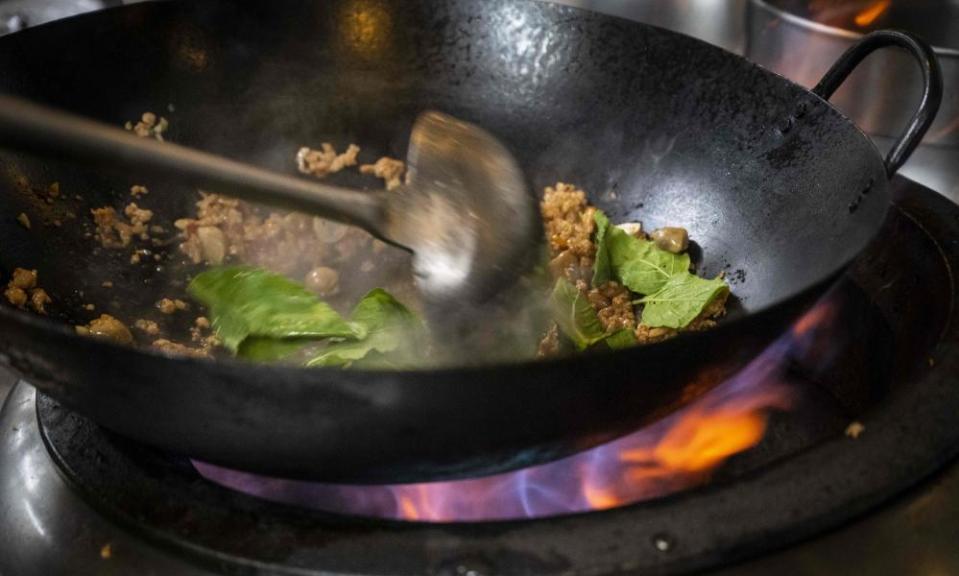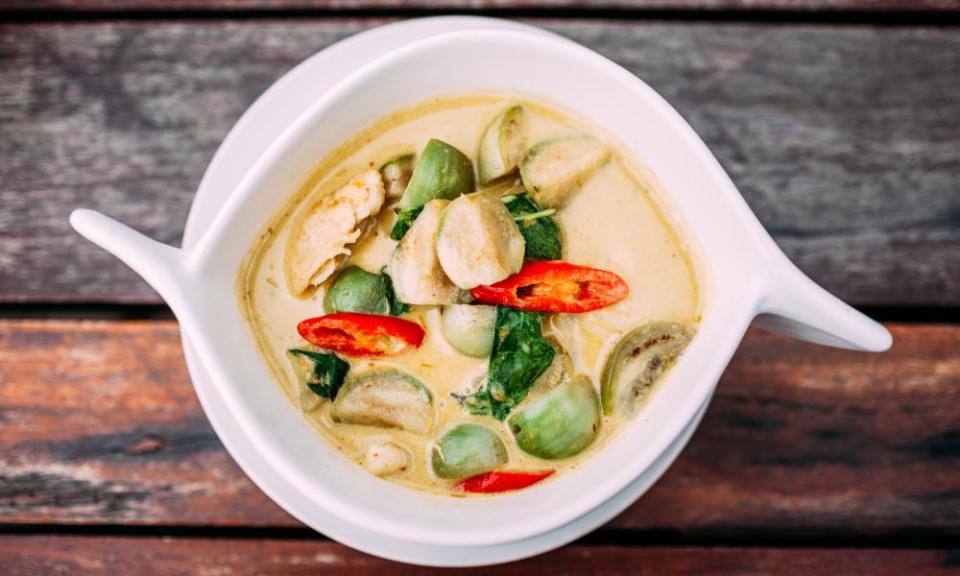Less but better: how to make meat the side, not the star
Growing up, I thought it normal that one whole chicken – cut up into many, many pieces in a curry or soup – was enough to feed a family of four, plus a few dinner guests.
My mother also encouraged us to have a completely meat free day – Tuesdays – because Monday was for eating up the weekend’s leftovers. Now, we are hearing more and more loudly the pleas to cut out meat from our diets altogether, and to consider veganism as the solution to climate change. Many may tread that path, and it is a valid one. Gradually my mother went that way – pescatarian to vegan. But I went another.
Related: The true cost of eating meat: if we want change, we have to pay for it
How I choose to cook and feed my family now is based on my upbringing, where the ratio of meat or eggs to vegetable, mushrooms and legumes sits somewhere around 1:10. Though we parted on our meat-eating stance, my mother and I did it for the same purpose: to somewhat reduce our consumption footprint. Now, I opt for ethical, non-conventionally farmed meat.
I choose to buy whole poultry which can be broken down and portioned. For lamb, beef, goat and larger animals, look into CSA meat boxes, or source from a reputable butcher who buys from farms that practice regenerative agriculture. Or better yet, from a farmer’s market where the farmer is also the stall-holder.
Related: How to feed the world - without killing everything
Supporting the people who practice in this way will often mean you end up paying higher, but fairer, prices for meat that is raised on pasture and likely to be more flavourful.
Here are some ideas on how to use that valuable, expensive, delicious meat minimally.
Steak
If we cook a steak for our family of four, we often cook a 200g piece, or heavier if it is on the bone, and make up four other sides of vegetables. Usually a leafy salad, a braised vegetable such as beans, roasted root vegetables and cooked greens.
Yes, it sounds like a lot of work for a little bit of meat, but think about it like this: the meat is one of the sides to the vegetable dishes, rather than the sun that everything else orbits around. For many of the sides, I use animal fats to roast or bake with, and salad dressing we can pre-make and refrigerate. With minimal reheating in the oven, I can turn out a weekday dinner in 20-30 minutes.
Meatballs
Truly meatballs are one of the best creations our species has come up with to make do. This is a universal food, of which I have eaten many variations (sausages are a form of meatball) across a broad spectrum of cuisines from louk chin and naem to polpettes or wanzi.
The idea is to stretch out the meat – offal, skin, fat and other off-cuts such as muscle meat – as far as possible by grinding it up to a manageable coarse or finer mince, then incorporate herbs, vegetables, starches or eggs to bulk it up, making it tender and delicious.
It is rare in traditional cuisines to eat a meatball plain, you will likely find them submerged in a sauce, soups or sandwiched between two pieces of bread (a hamburger).
I make mine with a variety of fresh herbs, dried herbs and spices, eggs and sometimes coarsely chopped prawns, which can be shaped into meatballs or become stuffing for dumplings or ravioli. Any leftovers can be frozen. I cook these meatballs in a soup (made from stock that is cooked down bones, off cuts, feet, necks) with softer greens like wombok, mushrooms, fresh herbs such as celery leaves or coriander and tofu. It’s hotpot style, but on the stove. Into the soup you can boost up your ferment intake by adding kimchi (kimchi stew) or stirring in some miso at the end, after you’ve turned off the heat.
Stir frying

Still my absolute go-to when I am time poor, but would rather eat food that I can cook, instead of ordering takeaway. For instance, last week I was given 250g of hangar steak by a neighbouring farmer who rears buffalo which I marinated then portioned into roughly 25g pieces. With that piece of hangar steak I’ve been cooking up stir fries with lots of vegetables. I use rendered fat on a very hot wok to sear the sides of the steak. Once it’s brown, I take that out then slice it very thinly. These pieces get tossed back into the wok as the vegetables are done cooking.
If you think that you need a lot of meat to feel satiated, you may find yourself surprised at how little you actually need with this method of cooking. The thing with stir frying is, because of the short cooking time and higher temperature, you want to slice your meat thinly to ensure that it is cooked perfectly without being too chewy.
Soups, curries, stews and braises

These are perfect for this cold weather. Make it about the vegetables, then meat can play a supporting role like in gaeng keow waan (green curry) where often the whole chicken is broken down on the bones. This makes it more toothsome, and you will not have to use a stock as the base because by cooking the chicken on the bone, it will release so much more flavour.
The chicken often plays second fiddle to the apple eggplants, pea eggplants and fresh Thai basil – which is what I tend to fish for out of the pot – leftovers are often the best bit if making a big pot. There are so many wonderful tubers and root vegetables in season for soups and curries right now, like carrots, swedes, colourful potatoes, parsnips, rutabaga, celery and daikon, alongside all the leafy winter brassicas. Load it up with dried herbs in the beginning, and fresh herbs at the end of the cooking process.
Pasta, fried rice and congee
Starchy dishes are a great way to deliver a little bit of protein and a lot of vegetables. A bit of cured meat can go a long way to give flavour and fat to any of these.
We are all on this planet together, so it is on us to solve its problems together. Our food consumption habits are directly linked to our broken food system, so it’s time to put some real skin in the game. Even if it’s as simple as cutting down your meat consumption and seeking out farmers who are trying to be better land stewards.

 Yahoo News
Yahoo News 
